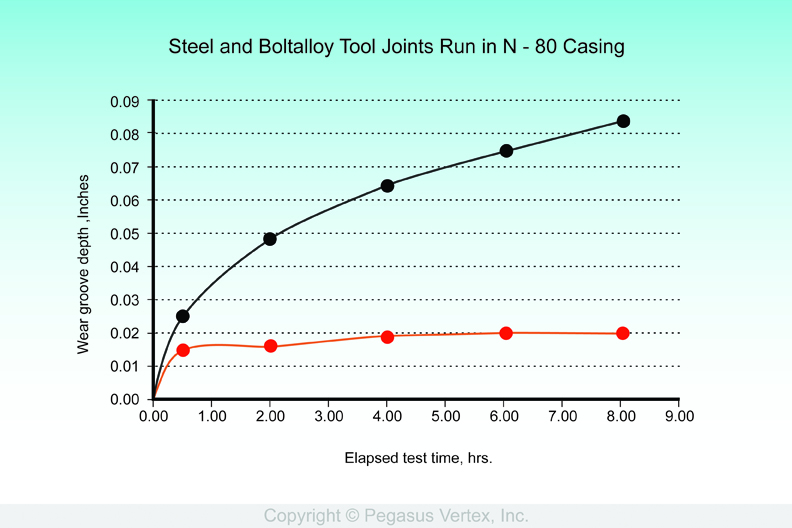If the casing wear groove depth limit is to be regarded as a `real world’ quantity, and not just a`mathematical peculiarity’, two things are required.
1. Experimental verification of the wear groove limit, and
2. A reasonable explanation for the existence of this casing wear groove depth limit.
An example showing (1) the existence of the casing wear groove depth limit and (2) the effect of tool joint hardbanding (Boltalloy) on casing wear depth is presented in Figure 1.
The upper curve represents the casing wear test data from Test # C – 3. In this test, the casing was 9 5/8 inch, 47 ppf N – 80: The tool joint was fabricated from AISI 4145 steel: and the drilling fluid was a 10 ppg. Water based mud containing 7 volume % Clemtex # 5 sand. The casing wear groove depth at the end of this 8 hour test was 0.081 inches.
The lower plot, labeled `BOLTALLOY’ , represents test data from a system which differs from that of the C – 3 test only in the metallurgy of the tool joint. The tool joint was hardbanded with a proprietary alloy. The depth of the casing wear groove was 0.02 inches at the end of this 8 hour casing wear test.
Use of the proprietary hardbanding reduced the casing wear groove depth in the N – 80 casing to a maximum depth limit of 0.02 inch. This is in contrast to the 0.1739 depth limit predicted for the N – 80 casing in the presence of the unhardbanded AISI 4145 steel tool joint.
The time required to reach 90 % of the wear groove depth limit for the BOLTALLOY test was 1.56 hours.
These results are similar to many other results that have been obtained during the DEA 42 Casing Wear Program, and they confirm the existence of the casing wear groove limit. It is a physical reality.
NOTE: Observations and conclusions regarding the performance of casing wear systems (which consist of (1) casing, (2) tool joint, (3) drilling fluid, and (4) operating conditions) are based on mathematical analyses of the statistical curve fit to the casing wear test data.

